Recent Mold Remediation Posts
The Hidden Dangers of Mold and How We Can Help
1/9/2025 (Permalink)
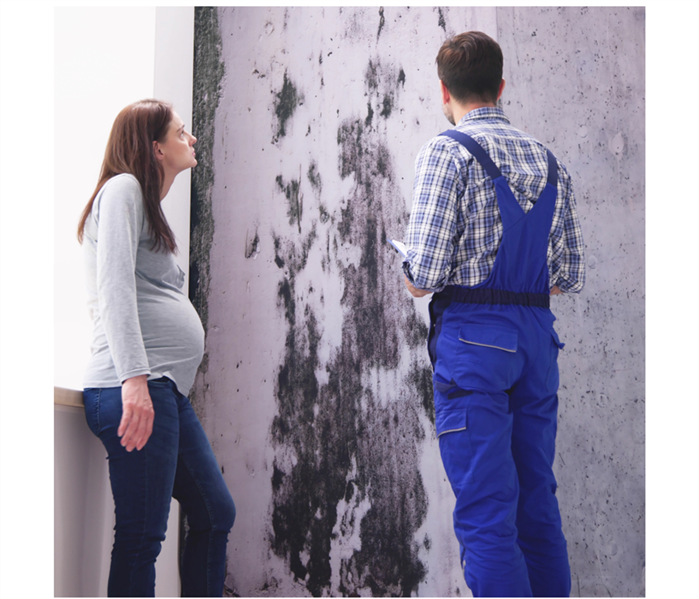 Mold may begin as a minor annoyance, but if ignored, it can become a serious structural hazard.
Mold may begin as a minor annoyance, but if ignored, it can become a serious structural hazard.
Mold may begin as a minor annoyance, but if ignored, it can become a serious structural hazard. Here’s what you need to know about mold’s risks and how we can help you address them.
Common Causes of Mold in Homes and Businesses
Mold thrives in damp, humid environments, often becoming a problem due to:
- Water damage or flooding
- Leaking plumbing
- Poor ventilation or high indoor humidity
Bathrooms, basements, and areas prone to condensation are especially vulnerable.
Signs You Need Professional Mold Removal
Watch for these warning signs that may indicate a mold problem:
- Persistent musty odors
- Discoloration or visible staining on walls, ceilings, or floors
SERVPRO’s Comprehensive Mold Remediation Process
At SERVPRO of Foxborough, we go beyond surface cleaning—we tackle mold at its source. Our process includes:
- Comprehensive Assessment: Determining the full scope of the mold issue.
- Containment: Preventing the spread of mold spores during remediation.
- Advanced Mold Removal: Using specialized equipment and techniques to remove mold safely and effectively.
- Restoration: Repairing and restoring your property to its original condition.
Preventive Tips to Keep Mold Away
Follow these tips to minimize the risk of mold growth:
- Keep indoor humidity levels below 60%.
- Address water damage and fix leaks promptly.
- Ensure adequate ventilation in moisture-prone areas, such as kitchens, bathrooms, and basements.
As a trusted leader in the restoration industry, SERVPRO of Foxborough has the expertise, training, and advanced equipment to help you restore your home or business to a safe, mold-free state. Contact us today for reliable mold remediation services!
Returning Home After Holiday Travel? Here’s How to Spot Water or Mold Damage Early
11/25/2024 (Permalink)
 Here’s a guide to inspecting your home for signs of water and mold damage after your trip.
Here’s a guide to inspecting your home for signs of water and mold damage after your trip.
Coming home after a holiday getaway should feel relaxing—unless something seems off in your space. Your home may have developed issues like water or mold damage while you were away, requiring swift action to avoid costly repairs. Catching these problems early can help you get back to your routine with peace of mind. Here’s a guide to inspecting your home for signs of water and mold damage after your trip.
1. Start with a Walkthrough
Before unpacking, take a slow walkthrough of your home. Use both your eyes and nose to detect any issues. Musty smells often indicate hidden mold or water damage. Focus on areas prone to dampness, such as basements, bathrooms, kitchens, and laundry rooms.
2. Look for Water Stains and Discoloration
Check walls, ceilings, and floors for new water stains, bubbling paint, or discoloration. These are common indicators of water damage caused by leaks or excess moisture. Prompt action here can prevent mold from taking hold.
3. Inspect Windows and Doors
Windows and doorframes are hotspots for moisture. Look for condensation, water stains, or warped materials. Foggy or dripping windows might signal a humidity problem or leaks that could lead to mold growth.
4. Examine Under Sinks and Plumbing Fixtures
Look under sinks and around toilets and pipes for dampness or standing water. Even a small, unnoticed leak can escalate, leading to mold growth and structural issues.
5. Check Around Appliances
Inspect refrigerators, dishwashers, washing machines, and other appliances for leaks. Look behind and underneath these units for water pooling or mold. A musty odor near them could also indicate hidden damage.
6. Don’t Forget the Attic and Basement
Attics and basements are particularly vulnerable to water and mold damage. In the attic, check for roof leaks, wet insulation, or darkened wood beams. In the basement, look for standing water, damp spots, or mold on walls and floors.
7. Assess Your Roof and Gutters
Winter weather can damage roofs and clog gutters, leading to leaks. Inspect your roof for visible damage and ensure your gutters are clear of debris or ice dams to prevent water from entering your home.
8. Monitor Indoor Humidity Levels
High humidity can fuel mold growth. Use a hygrometer to ensure your home’s humidity is between 30-50%. A dehumidifier can help control moisture if levels are too high.
9. Pay Attention to Odors
Even if there are no visible signs of damage, a musty or earthy smell may point to hidden mold. Trust your nose—it’s often the first clue that something is wrong.
10. Take Immediate Action
If you spot any signs of water or mold damage, act quickly. Addressing these issues early can save money and prevent health risks. For severe damage, contact a professional restoration service to assess and repair the problem thoroughly.
Tips to Prevent Issues Before Your Next Trip
Avoid post-travel surprises by taking these steps before leaving:
- Turn off the water supply, especially in winter.
- Insulate pipes and winterize outdoor faucets.
- Keep your thermostat at a temperature that prevents freezing.
- Arrange for someone you trust to check your home periodically.
Returning to unexpected water or mold damage can be stressful, but early detection and quick action make all the difference. Regular maintenance and preparation ensure your home stays in excellent shape, letting you fully enjoy your time away.
SERVPRO of Foxborough is here to help if you discover water or mold damage. Our trained professionals use advanced equipment to restore your property.
Understanding and Preventing Mold Growth in Buildings During Summer Months
7/29/2024 (Permalink)
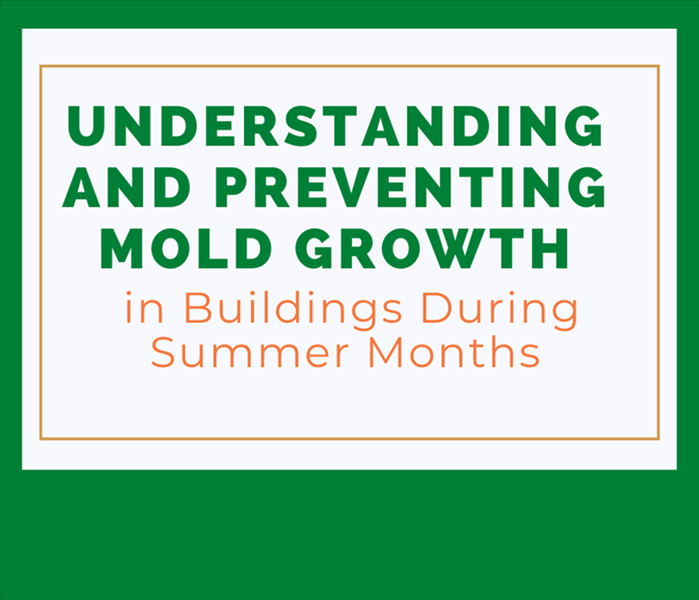 Preventing mold growth during the summer months requires proactive measures to control humidity, improve ventilation
Preventing mold growth during the summer months requires proactive measures to control humidity, improve ventilation
As temperatures rise during the summer months, the risk of mold growth in buildings also increases. Mold thrives in warm, humid environments, making summer the perfect season for it to flourish. Understanding the causes of mold growth and how to prevent it is crucial for maintaining a healthy indoor environment.
The Causes of Mold Growth in Summer
- High Humidity Levels: Summer months often bring increased humidity, creating an ideal environment for mold. Mold spores require moisture to grow, and high humidity levels provide the necessary conditions.
- Poor Ventilation: Buildings with poor ventilation can trap moisture inside, leading to condensation on walls, ceilings, and floors. This trapped moisture provides a breeding ground for mold.
- Water Leaks and Dampness: Leaking pipes, roofs, and windows can introduce excess moisture into a building. Even minor leaks can create damp areas where mold can thrive.
- Condensation: Air conditioning systems can sometimes cause condensation, especially if they are not properly maintained. This condensation can accumulate and lead to mold growth.
Prevention Tips
- Control Humidity Levels: Use dehumidifiers to maintain indoor humidity levels below 60%. Air conditioning can also help reduce humidity, but ensure that the system is well-maintained to prevent condensation.
- Improve Ventilation: Ensure that your building has adequate ventilation. Use exhaust fans in bathrooms, kitchens, and laundry rooms to expel moisture. Opening windows can also help improve air circulation.
- Fix Leaks Promptly: Regularly inspect your building for leaks and address them immediately. Pay attention to areas around windows, roofs, and pipes. Fixing leaks promptly can prevent moisture buildup.
- Clean and Dry Damp Areas: If you notice any damp areas in your building, clean and dry them immediately. Use fans and dehumidifiers to speed up the drying process.
- Use Mold-Resistant Products: Consider using mold-resistant products, such as mold-resistant drywall and paint, in areas prone to moisture, like bathrooms and basements.
- Regular Maintenance: Perform regular maintenance checks on your HVAC system, plumbing, and roofing. Ensure that gutters and downspouts are clear of debris to prevent water from seeping into the building.
Preventing mold growth during the summer months requires proactive measures to control humidity, improve ventilation, and address any sources of moisture. By following these tips, you can create a healthier indoor environment and protect your building from the damaging effects of mold. Remember, early detection and prevention are key to keeping mold at bay.
Choose the #1 Experts in Cleanup and Restoration for Residential and Commercial Fire, Mold, Water, and Storm Damage. Contact us today! We can assist with your damage and restoration needs in Foxborough.
Understanding Mold: FAQs and Answers
7/17/2024 (Permalink)
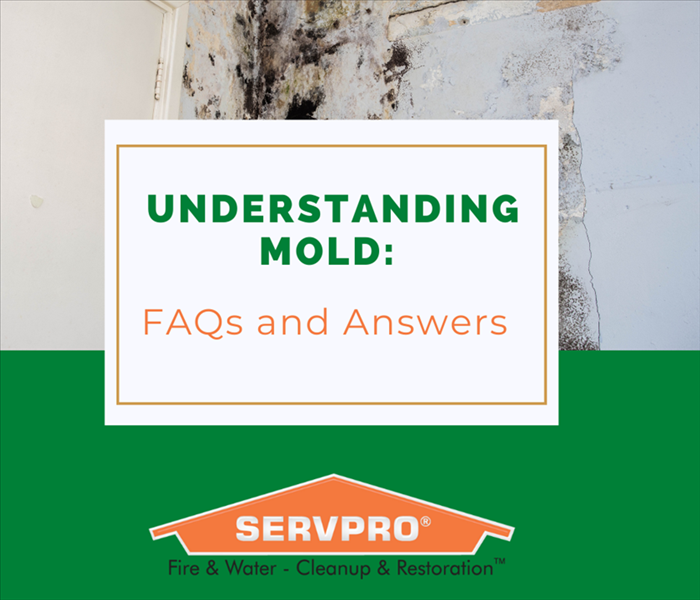 If you have a mold problem that is too large to handle on your own, don’t hesitate to seek professional help.
If you have a mold problem that is too large to handle on your own, don’t hesitate to seek professional help.
Mold is a common issue that many homeowners and property managers face. To help you better understand mold and how to deal with it, we've compiled a list of frequently asked questions about mold in Norfolk, MA:
What is Mold?
Mold is a type of fungus that thrives in moist environments. It reproduces by creating spores, which can spread through the air and settle on surfaces, where they can grow and multiply.
Where Does Mold Typically Grow?
Mold can grow on virtually any surface where moisture is present. Common areas for mold growth include bathrooms, kitchens, basements, and areas with water damage.
How Can I Prevent Mold Growth in My Home?
To prevent mold growth, it’s essential to control moisture levels in your home. This can be achieved by:
- Fixing leaks
- Using exhaust fans in bathrooms and kitchens
- Using a dehumidifier in damp areas
How Do I Know If I Have a Mold Problem?
Signs of a mold problem include:
- Visible mold growth
- A musty odor
- Water stains on walls or ceilings
If you suspect you have a mold problem, it’s best to have a professional inspection to assess the extent of the issue.
How Should Mold Be Removed?
Small areas of mold can often be cleaned with a mixture of water and detergent. However, larger mold infestations may require professional remediation to ensure that the mold is properly removed and does not return.
How Can I Prevent Mold from Coming Back After It’s Been Removed?
To prevent mold from returning, it’s important to address the underlying moisture issue. This may involve:
- Fixing leaks
- Improving ventilation
- Using a dehumidifier to reduce moisture levels in the air
Is Mold Covered by Insurance?
Coverage for mold damage depends on your insurance policy and the cause of the mold. Some insurance policies may cover mold damage if it is the result of a covered peril, such as a burst pipe. However, coverage can vary, so it’s best to check with your insurance provider.
By understanding mold and how to prevent and address it, you can protect your home. If you have a mold problem that is too large to handle on your own, don’t hesitate to seek professional help.
Choose the #1 Experts in Cleanup and Restoration for Residential and Commercial Fire, Mold, Water, and Storm Damage. Contact us today! We can assist with your damage and restoration needs in Norfolk, MA.
The Impact of Summer Mold on Indoor Air Quality
7/16/2024 (Permalink)
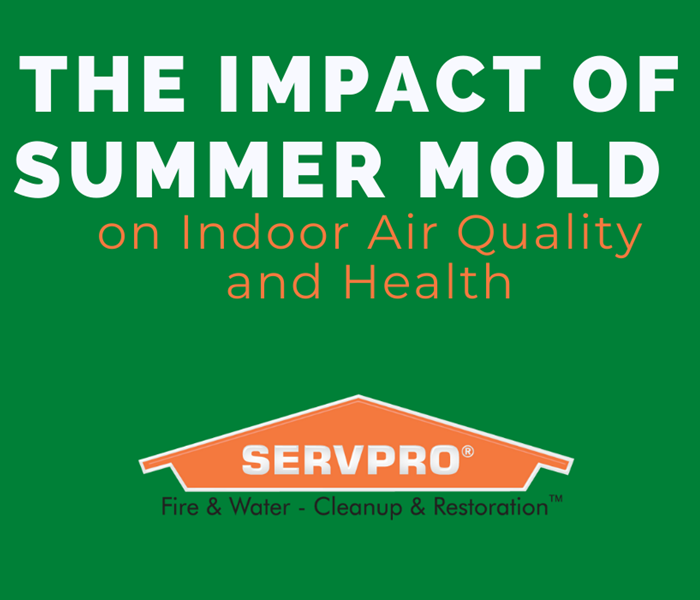 Regular maintenance, proper ventilation, and prompt action are key to maintaining a healthy indoor environment.
Regular maintenance, proper ventilation, and prompt action are key to maintaining a healthy indoor environment.
Summer brings warm weather and longer days, but it also increases the risk of mold growth in buildings. Mold not only damages structures but also poses significant health risks to occupants. Understanding how mold affects indoor air quality.
How Mold Affects Indoor Air Quality
- Release of Spores: Mold releases tiny spores into the air, which can be inhaled by occupants. These spores can trigger allergic reactions and respiratory issues, especially in individuals with preexisting conditions.
- Mycotoxins: Some types of mold produce mycotoxins, which are toxic substances that can contaminate the air. Exposure to mycotoxins can lead to more severe health problems, including neurological symptoms and immune system suppression.
- Odor: Mold growth often results in a musty odor, which can make indoor spaces unpleasant and indicate poor air quality. This odor can be persistent and difficult to eliminate without addressing the underlying mold issue.
Tips to Protect Indoor Air Quality
- Regular Cleaning: Keep your building clean and dry. Regularly clean surfaces prone to moisture, such as bathrooms and kitchens, with mold-inhibiting cleaners.
- Monitor Humidity Levels: Use hygrometers to monitor indoor humidity levels. Aim to keep humidity below 60% to prevent mold growth. Dehumidifiers can help control moisture levels.
- Improve Air Circulation: Ensure proper ventilation throughout the building. Use exhaust fans in high-moisture areas and open windows to improve air circulation.
- Address Water Issues Promptly: Fix any leaks and address water damage immediately. Dry out wet areas within 24-48 hours to prevent mold growth.
- Use Air Purifiers: Consider using air purifiers with HEPA filters to remove mold spores and other allergens from the air.
- Educate Occupants: Inform building occupants about the risks of mold and how to prevent it. Encourage them to report any signs of mold growth or water damage promptly.
Mold growth during the summer months can significantly impact indoor air quality. By understanding the risks and taking proactive measures to prevent mold, you can protect your building and its occupants from the harmful effects of mold exposure. Regular maintenance, proper ventilation, and prompt action are key to maintaining a healthy indoor environment.
Choose the #1 Experts in Cleanup and Restoration for Residential and Commercial Fire, Mold, Water, and Storm Damage. Contact us today! We can assist with your damage and restoration needs in Norfolk, MA.
Protecting Your Home From Mold in Franklin, MA
4/17/2024 (Permalink)
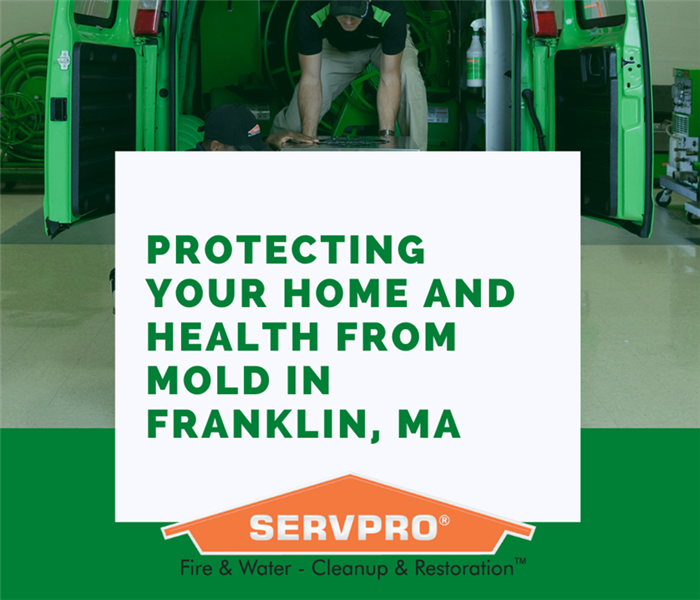 Mold thrives in damp, humid environments, making it a common problem following flood or leak incidents
Mold thrives in damp, humid environments, making it a common problem following flood or leak incidents
Water damage can lead to a host of issues in your home, but one of the most concerning is mold growth.
Mold thrives in damp, humid environments, making it a common problem following flood or leak incidents. Proper mold remediation and prevention are crucial for maintaining a safe, healthy living space.
Identifying Mold Growth
Catching mold early is key to effective remediation. Look out for musty odors and visible growth on walls, ceilings, or other surfaces. However, mold can also lurk in hidden areas like behind walls or under flooring, so a thorough professional inspection is necessary.
Safe Mold Removal
Never attempt to remove mold yourself, as disturbing growth can cause spores to spread through the air. Mold remediation requires specialized equipment and containment techniques to remove it safely. Trained professionals use proven methods to ensure your home is restored while protecting you and your family.
Preventing Future Issues
Once mold is removed, it's essential to prevent future growth. Repair any leaks or moisture sources, dry out wet areas completely, and maintain low indoor humidity below 60%. Use dehumidifiers, ensure proper ventilation in bathrooms/kitchens, and promptly address any new moisture issues.
Don't let mold jeopardize your home after water damage. At SERVPRO of Foxborough, our mold remediation experts are prepared to safely and effectively remove mold from your property. Our advanced techniques and equipment get your home back to pre-damage condition quickly. We also provide comprehensive water damage restoration services to get your property dried out and prevent recurring mold issues.
When disaster strikes, trust the professionals at SERVPRO of Foxborough. We rapidly respond to any size fire, water, mold, or storm emergency, with the training and experience to make it "Like it never even happened."
Service Areas
Franklin, MA | Millis, MA | Wrentham, MA | Foxborough, MA | Wethersfield, MA | Bellingham, MA | Norfolk, MA
Is Mold a Winter Worry? Exploring Cold-Weather Mold Concerns In Foxborough MA.
1/9/2024 (Permalink)
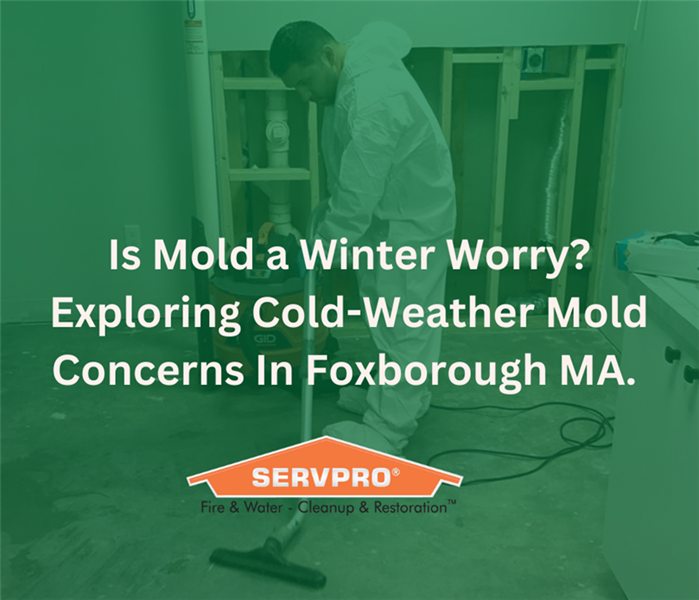 While mold concerns may not be as prominent in winter as in warmer seasons, cold weather brings conditions that can contribute to mold growth.
While mold concerns may not be as prominent in winter as in warmer seasons, cold weather brings conditions that can contribute to mold growth.
When contemplating mold growth, the association with damp and warm environments is common, but mold is not exclusive to the summer months.
Winter introduces its own set of conditions that can contribute to mold growth in unexpected places. Let's explore whether mold is a concern during winter and discuss the cold-weather considerations that homeowners and businesses should be aware of in Foxborough, MA.
Condensation and Indoor Humidity:
- Cold-Weather Concern: Temperature differentials between outdoor and indoor environments in winter can lead to condensation on windows, walls, and surfaces. Combined with indoor humidity, this creates conditions conducive to mold growth.
- Preventive Measures: Maintain indoor humidity below 60% and use exhaust fans in moisture-prone areas like bathrooms and kitchens. Ensure proper ventilation to reduce condensation on windows.
Ice Dams and Roof Leaks:
- Cold-Weather Concern: Ice dams, formed by melting and refreezing snow on roofs, can result in water infiltration and roof leaks. Moisture from leaks can create favorable conditions for mold growth in attics and ceilings
- Preventive Measures: Properly insulate and ventilate attics to prevent ice dams. Regularly inspect roofs for leaks and address issues promptly to prevent water damage.
Mold in Heating Systems:
- Cold-Weather Concern: Mold can thrive in heating systems, particularly in ductwork and on heating coils. As warm air circulates through the system, it can spread mold spores throughout the building.
- Preventive Measures: Regularly inspect and clean HVAC systems, including ductwork and coils. Use high-quality air filters and consider professional HVAC maintenance.
Basement Moisture Issues:
- Cold-Weather Concern: Cold temperatures may lead to condensation on basement walls and floors. Additionally, melting snow and frozen ground can contribute to moisture entering basements.
- Preventive Measures: Seal cracks in basement walls, ensure proper drainage away from the foundation, and use dehumidifiers to control indoor humidity levels.
Firewood Storage:
- Cold-Weather Concern: Storing firewood indoors for winter heating can introduce moisture, creating a conducive environment for mold growth.
- Preventive Measures: Store firewood outdoors in a dry, covered area, and bring in small amounts at a time. Keep firewood away from walls and off the ground.
While mold concerns may not be as prominent in winter as in warmer seasons, cold weather brings conditions that can contribute to mold growth. Understanding these cold-weather mold concerns and implementing preventive measures, such as regular maintenance, proper ventilation, and moisture control, is crucial for ensuring a healthy and mold-free indoor environment throughout the winter months in Foxborough, MA.
Understanding Water and Mold Damage from Winter Pipe Breaks in Foxborough, MA.
12/8/2023 (Permalink)
 Winter pipe breaks and the subsequent water and mold damage can be a homeowner's nightmare.
Winter pipe breaks and the subsequent water and mold damage can be a homeowner's nightmare.
As winter blankets the world in a serene layer of snow, it also brings forth the potential for a less picturesque, yet all too common, issue: frozen pipes.
The frigid temperatures can wreak havoc on plumbing systems, leading to pipe breaks that result in water damage and, subsequently, mold growth. Read about the causes of winter pipe breaks, the consequences of water damage, and effective measures to prevent and mitigate the aftermath in Foxborough, MA.
Understanding Winter Pipe Breaks:
- Freezing Temperatures: The most common cause of winter pipe breaks is freezing temperatures. When water inside pipes freezes, it expands, putting immense pressure on the pipe walls. This increased pressure can lead to cracks, bursts, or even complete ruptures in the plumbing system.
- Poor Insulation: Inadequate insulation around pipes increases the likelihood of freezing. Exposed pipes in attics, basements, or crawl spaces are particularly vulnerable. Proper insulation helps maintain a consistent temperature and protects pipes from the harsh winter cold.
Consequences of Winter Pipe Breaks:
- Water Damage: A burst pipe can release a significant amount of water into your home or business, causing extensive damage to walls, floors, and belongings. Swift action is crucial to prevent further harm and reduce repair costs.
- Mold Growth: Once water is introduced into the equation, the risk of mold growth skyrockets. Mold thrives in damp, humid environments, and the aftermath of a pipe break provides the perfect breeding ground. Mold not only damages structures but also poses health risks, especially for individuals with respiratory issues.
Preventing and Mitigating Water Damage:
- Insulate Pipes: Ensure all pipes, especially those in vulnerable areas, are properly insulated. This helps maintain a consistent temperature and reduces the risk of freezing.
- Keep Interior Spaces Warm: Maintain a warm environment within your home or business, especially in areas with exposed pipes. This can be achieved through proper heating and insulation.
- Drip Faucets: During extremely cold nights, allow faucets to drip slowly. This keeps water flowing, reducing the likelihood of pipes freezing.
- Seal Leaks: Regularly inspect and seal any leaks in your home's structure. Even small leaks can lead to significant problems when temperatures drop.
- Emergency Plan: Have an emergency plan in place. Know the location of your main water shut-off valve and how to turn it off quickly. This can help minimize damage in the event of a pipe break.
Winter pipe breaks and the subsequent water and mold damage can be a homeowner's nightmare. However, with proper precautions and a proactive approach to maintenance, you can significantly reduce the risk of such incidents. Remember, prevention is key, but in the unfortunate event of a pipe break, swift action is crucial to mitigate the damage and protect your home from the harsh consequences of winter's icy grip.
SERVPRO Of Foxborough is The #1 Choice in Cleanup and Restoration for residential and commercial buildings’ water damage.
Sump Pump Failure and the Importance of Preparedness
11/11/2023 (Permalink)
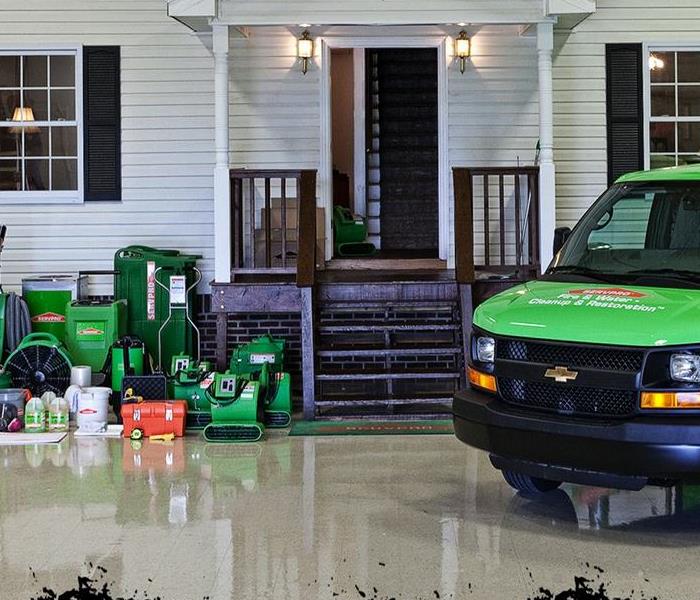 Sump pump failure poses an often underestimated yet substantial threat to the safety and integrity of your home.
Sump pump failure poses an often underestimated yet substantial threat to the safety and integrity of your home.
In the realm of home maintenance and protection, a hidden hero lurks in basements and crawl spaces—the sump pump. While quietly executing its duty to shield homes from potential water damage, its failure can unleash disastrous consequences. Uncover the reasons behind sump pump failures, recognize warning signs, and implement essential measures to fortify your home's protection.
The Unassuming Defender:
The unpretentious sump pump plays a critical role in averting basement flooding. Nestled in a specially designed pit, it senses rising water levels and redirects excess water away from your home's foundation. This straightforward yet effective system serves as a homeowner's initial defense against water damage triggered by heavy rainfall, melting snow, or elevated groundwater.
Common Causes of Sump Pump Failure:
- Power Outages: Deprived of electricity, the pump remains inoperable, leaving your basement susceptible to flooding.
- Lack of Maintenance: Like any mechanical system, regular upkeep is essential for sump pumps. Accumulation of debris and sediment over time can impede the pump's efficiency.
- Float Switch Issues: Responsible for triggering the pump when water levels rise, the float switch can encounter mechanical failures or obstructions, impeding proper functionality.
- Frozen Discharge Pipe: In colder climates, a frozen discharge pipe can prevent the pump from expelling water, leading to potential backflow into the basement.
- Pump Overwhelm: Amidst heavy rainfall or rapid snowmelt, the sump pump may be inundated, working harder and risking failure.
Recognizing the Signs: To prevent surprise sump pump failures, stay alert for warning signs such as unusual noises—grinding or clanking may indicate mechanical issues within the pump.
Visible Rust or Corrosion: Rust or corrosion on the pump or its components signals wear and tear, potentially resulting in failure.
Frequent Cycling: An unusually frequent on-off cycle may indicate issues with the float switch or other components.
Foul Odors: Unpleasant smells suggest stagnant water in the sump pit, a consequence of the pump failing to effectively remove water.
Implement routine maintenance to clear debris, test the float switch, and verify the correct functioning of all components. Additionally, install a battery backup system to keep your sump pump operational during power outages.
Sump pump failure poses an often underestimated yet substantial threat to the safety and integrity of your home. By comprehending common causes, identifying warning signs, and taking proactive steps, you can diminish the risk of basement flooding and safeguard your property from the potential fallout of sump pump failure.
SERVPRO Of Foxborough is The #1 Choice in Cleanup and Restoration for residential and commercial buildings’ mold damage. Call us today at (508) 533-5305.
Mold FAQ: Your Comprehensive Guide to Understanding Mold
10/24/2023 (Permalink)
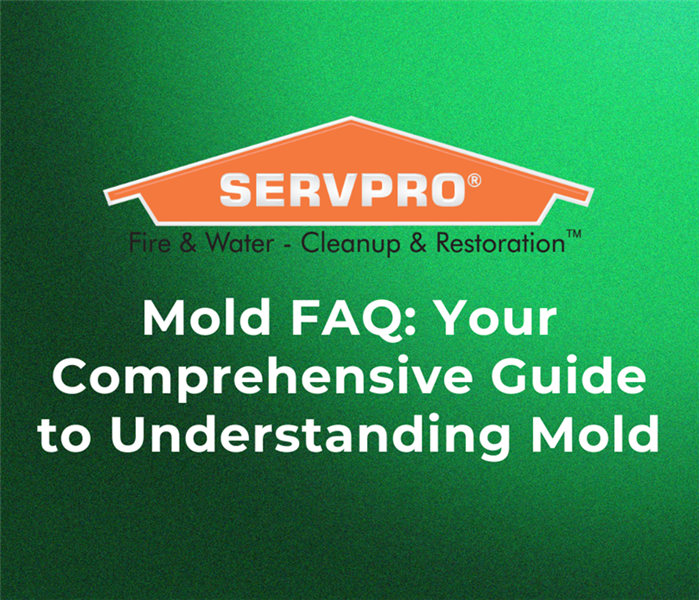 Consult with experts for guidance and remediation services to maintain a mold-free and safe living environment for your family.
Consult with experts for guidance and remediation services to maintain a mold-free and safe living environment for your family.
Mold poses a common household challenge that can result in various health concerns and property issues in Foxborough, MA. Many residents have inquiries about mold, and here are responses to frequently asked questions (FAQs) to enhance your understanding of this problem and its effective management.
What is Mold?
Mold is a fungus that grows in the form of multicellular filaments called hyphae. Flourishing in damp, humid conditions, it exhibits various colors and textures. While some molds are innocuous, others produce mycotoxins, potentially harmful to human health.
What Causes Mold Growth?
Mold necessitates moisture, warmth, and organic material for growth. Common triggers for mold in homes include water leaks, high humidity, poor ventilation, and damp building materials. Areas like bathrooms, basements, and kitchens are particularly prone to mold infestations.
Is Mold Dangerous to Health?
Indeed, mold can be harmful, especially if it produces mycotoxins. Exposure to mold spores and mycotoxins can lead to allergies, respiratory problems, skin irritation, and more severe conditions in immunocompromised individuals. Swiftly addressing mold problems is crucial for safeguarding health.
How Can I Prevent Mold Growth?
Proactive steps to prevent mold growth include:
- Control indoor humidity levels (ideally between 30-50%).
- Promptly fix leaks or water damage.
- Ensure proper ventilation in high-moisture areas.
- Use exhaust fans in bathrooms and kitchens.
- Promptly clean and dry wet or damp materials and surfaces.
How Do I Identify Mold in My Home?
Mold is identifiable by its fuzzy or slimy appearance and various colors like black, green, white, or brown. A musty odor may also be present. Consult a professional for a thorough inspection if you suspect mold in Franklin, MA.
Can I Remove Mold Myself?
For small, surface-level mold issues (under 10 square feet), self-cleaning with protective gear is possible. For extensive infestations, consulting a professional mold remediation service is advisable.
How Can I Prevent Mold Recurrence?
Maintain a dry, well-ventilated environment, inspect for leaks regularly, and promptly address moisture issues. Consider using dehumidifiers and ensure your HVAC system is well-maintained.
Do Home Insurance Policies Cover Mold Damage?
Coverage for mold damage in home insurance policies can vary. Review your policy and consult with your provider to ensure adequate coverage.
Understanding mold and employing preventive measures, addressing moisture promptly, and seeking professional help when needed can effectively manage and mitigate mold problems in your Wethersfield, MA home. Consult with experts for guidance and remediation services to maintain a mold-free and safe living environment for your family.
SERVPRO® Of Foxborough is The #1 Choice in Cleanup and Restoration for residential and commercial buildings’ fire, mold, water, and storm damage. Call us today at (508) 533-5305.
Dealing with Mold: Your Comprehensive Guide to Mold Remediation
9/20/2023 (Permalink)
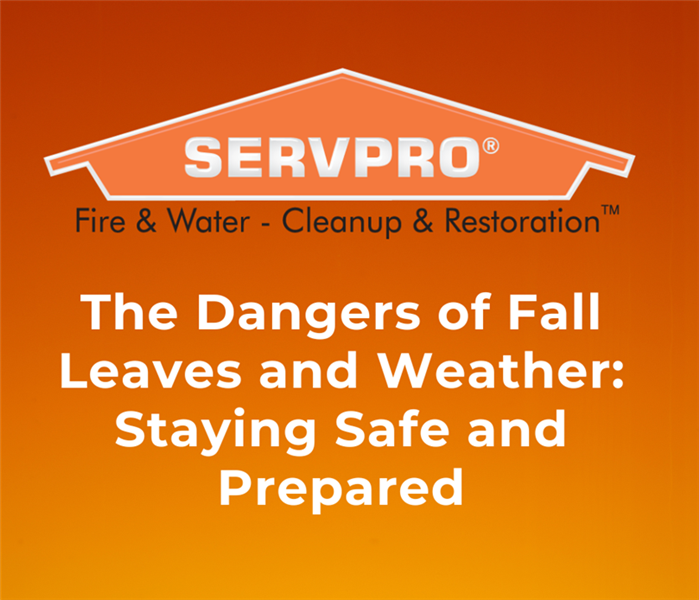 If the mold problem is extensive, toxic mold is suspected, or you have health concerns, it's advisable to hire a professional mold remediation service
If the mold problem is extensive, toxic mold is suspected, or you have health concerns, it's advisable to hire a professional mold remediation service
Not only is mold unsightly, but it can also pose health risks if left unaddressed. Here is what to do if you discover mold in your home and how to effectively tackle this issue.
- Identify the Mold: Before you can effectively deal with mold, you need to identify the type and extent of the infestation. If you are unsure about the type of mold you are dealing with, consider hiring a professional mold inspector who can provide an accurate assessment.
- Safety First: When dealing with mold, safety should be your top priority. Mold can release harmful spores and mycotoxins into the air, which can be dangerous when inhaled. To protect yourself, follow these safety precautions:
- Wear protective gear, including an N95 respirator, gloves, and eye protection.
- Isolate the contaminated area to prevent mold spores from spreading to other parts of your home.
- Ensure proper ventilation by opening windows and doors to allow fresh air to circulate.
- Remove Moisture Sources: Mold thrives in moist environments, so the first step in mold remediation is to identify and eliminate the source of moisture. Fix any leaks, repair roof damage, and improve ventilation in damp areas like basements and bathrooms. A dehumidifier can also help reduce humidity levels in your home.
- Cleaning and Mold Removal: The method of mold removal depends on the extent of the infestation and the affected materials.
- For small surface mold growth, clean the affected area with a mixture of soap and water or a commercial mold cleaner.
- For larger infestations, you may need to remove and replace contaminated materials, such as drywall, insulation, or carpet. Be cautious not to disturb the mold, as this can release more spores into the air.
- Consider Professional Help: If the mold problem is extensive, toxic mold is suspected, or you have health concerns, it's advisable to hire a professional mold remediation service. These experts have the necessary equipment and expertise to safely and effectively remove mold from your home.
After you have successfully removed the mold, take steps to prevent it from returning:
- Maintain proper ventilation and humidity levels in your home.
- Regularly inspect and repair any leaks or water damage.
- Clean and dry damp areas promptly.
- Use mold-resistant materials in areas prone to moisture.
Dealing with mold can be a daunting task, but with the right knowledge and precautions, you can effectively address the issue and protect your home and health. Remember that safety should always come first, and when in doubt, seek professional assistance. By identifying and addressing the source of the problem and following proper remediation procedures, you can create a healthier living environment for you and your family.
SERVPRO Of Foxborough is The #1 Choice in Cleanup and Restoration for residential and commercial buildings’ fire, mold, water, and storm damage. If you are looking for assistance, just click on the contact us page, and someone will be in touch shortly.
Can Mold Cause A Smell To The House?
5/18/2023 (Permalink)
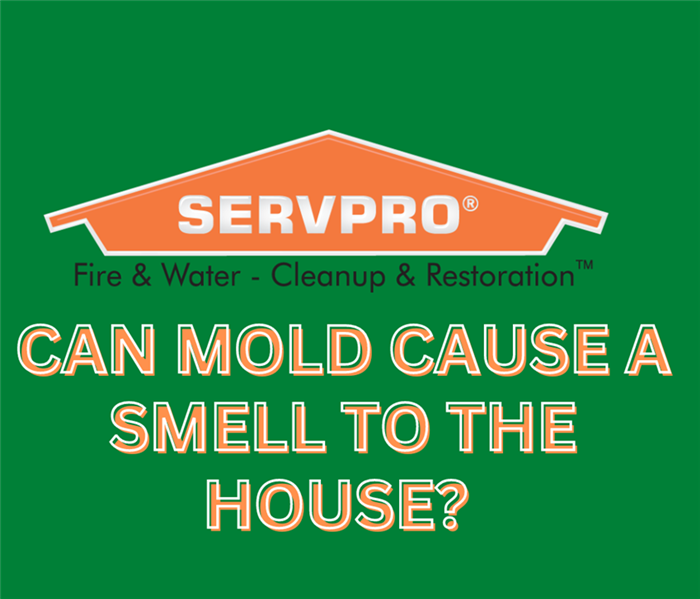 Reduce humidity levels, fix leaks, use ventilation, and clean regularly to prevent mold growth.
Reduce humidity levels, fix leaks, use ventilation, and clean regularly to prevent mold growth.
Not only can mold cause damage to your home and pose health risks, but it can also create a foul smell that can be difficult to get rid of. Here is what you can do to prevent mold.
What Causes the Smell?
Mold releases a musty odor that can be quite unpleasant. This smell is caused by the chemicals released by mold as it grows and breaks down organic matter. Mold thrives in damp environments, such as bathrooms, basements, and areas with water damage. If you notice a musty odor in your home, it could be a sign that mold is present.
Health Risks Associated with Mold.
Mold not only creates a foul smell but can also pose health risks to you and your family. Exposure to mold can cause allergic reactions, respiratory problems, and other health issues. Children, the elderly, and people with weakened immune systems are particularly vulnerable to mold-related health problems. If you suspect that mold is present in your home, it's important to take action to address the issue as soon as possible.
Here are some steps you can take to prevent mold growth in your home:
- Reduce humidity levels: Mold thrives in humid environments, so it's important to keep humidity levels low. Use dehumidifiers in areas prone to moisture, such as basements and bathrooms.
- Fix leaks: Mold needs moisture to grow, so fixing any leaks in your home is crucial. Check for leaks around windows, doors, and pipes, and repair them promptly.
- Use ventilation: Proper ventilation can help prevent mold growth. Use exhaust fans in bathrooms and kitchens, and open windows to increase airflow.
- Clean regularly: Regular cleaning can help prevent mold growth. Clean surfaces regularly with a solution of bleach and water, and use mold-resistant paint in areas prone to moisture.
If you discover mold in your home, it's important to take action to remove it as soon as possible. Here are some steps you can take to remove mold:
- Identify the source: Identify the source of the moisture that's causing the mold to grow. Fix any leaks or water damage before removing the mold.
- Use protective equipment: Wear protective equipment, such as gloves and a mask, to avoid inhaling mold spores.
- Clean surfaces: Clean surfaces with a solution of bleach and water. Use a scrub brush to remove the mold from porous surfaces, such as drywall.
- Dry the area: After cleaning the mold, dry the area thoroughly to prevent the mold from returning.
Prevention is key when it comes to dealing with mold. Reduce humidity levels, fix leaks, use ventilation, and clean regularly to prevent mold growth. If you discover mold in your home, take action to remove it promptly.
SERVPRO Of Foxborough is The #1 Choice in Cleanup and Restoration for residential and commercial buildings’ fire, mold, water, and storm damage.
What to do if there is mold in your walls
4/7/2023 (Permalink)
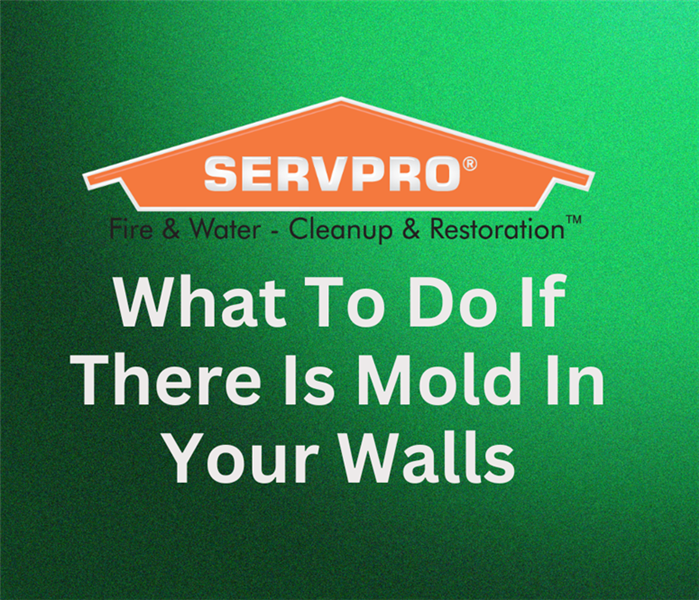 Mold on your walls is not only unsightly, but it can also be a health hazard if left untreated.
Mold on your walls is not only unsightly, but it can also be a health hazard if left untreated.
Mold on your walls is not only unsightly, but it can also be a health hazard if left untreated.
Here are some steps you can take to deal with mold on your walls:
- Identify the cause of the mold: The first step in dealing with mold on your walls is to identify the underlying cause. Mold thrives in damp, humid environments, so it's important to identify any sources of moisture that may be contributing to the problem. Common causes of mold on walls include leaky pipes, roof leaks, high humidity levels, and poor ventilation.
- Remove the mold: Once you have identified the cause of the mold, it's time to remove it from your walls. Depending on the severity of the mold, you may be able to clean it yourself using a mixture of water and bleach or vinegar. However, if the mold has spread over a large area or is particularly stubborn, it's best to call in a professional mold remediation company to ensure that it is completely removed.
- Repair any damage: Once the mold has been removed, it's important to repair any damage to your walls. This may include replacing any damaged drywall or insulation, repairing leaks, or installing a dehumidifier to help control moisture levels.
- Prevent future mold growth: To prevent mold from growing on your walls in the future, it's important to take steps to control moisture levels in your home. This may include repairing any leaks promptly, using a dehumidifier in areas with high humidity, and ensuring that your home is properly ventilated.
Dealing with mold on your walls can be a daunting task, but it's important to take action as soon as possible to prevent it from spreading and causing further damage.
We service Bellingham, Foxborough, Franklin, Millis, Norfolk, Wethersfield, and Wrentham, MA
SERVPRO Of Foxborough is The #1 Choice in Cleanup and Restoration for residential and commercial buildings’ fire, mold, water, and storm damage.
How to prevent mold damage in Foxborough MA
3/5/2023 (Permalink)
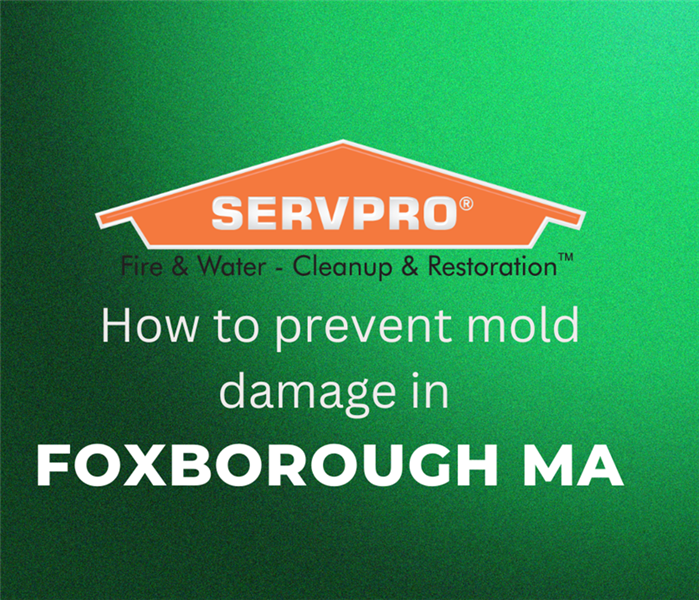 SERVPRO Of Foxborough is The #1 Choice in Cleanup and Restoration for residential and commercial buildings’ fire, mold, water, and storm damage.
SERVPRO Of Foxborough is The #1 Choice in Cleanup and Restoration for residential and commercial buildings’ fire, mold, water, and storm damage.
Mold grows in damp and humid environments, and it can thrive on various surfaces, including walls, ceilings, carpets, and furniture. Fortunately, there are ways to prevent mold damage in your home.
- Keep your home dry: Mold thrives in damp and humid environments, so the best way to prevent mold damage is to keep your home dry. You can do this by fixing any leaks in your plumbing, roof, or windows. Make sure that your home is properly ventilated, especially in areas like the bathroom, kitchen, and laundry room.
- Clean and maintain your HVAC system: Your HVAC system plays a crucial role in maintaining the air quality in your home. It can also help to prevent mold growth. Make sure to clean and maintain your HVAC system regularly to prevent any buildup of dust or moisture, which can lead to mold growth.
- Use mold-resistant products: When renovating or building your home, consider using mold-resistant materials such as drywall, paints, and insulation. These materials are specially designed to resist mold growth.
- Monitor indoor humidity levels: Mold thrives in humid environments, so it's important to keep an eye on indoor humidity levels. The ideal humidity level is between 30 and 50 percent. You can use a hygrometer to measure the humidity levels in your home.
- Clean and dry any water damage promptly: Water damage is one of the leading causes of mold growth. If you experience any water damage in your home, it's important to clean and dry the affected area as soon as possible.
Mold damage can be a significant problem for homeowners, but it's a problem that can be prevented. By keeping your home dry, maintaining your HVAC system, using mold-resistant products, monitoring indoor humidity levels, and cleaning and drying any water damage promptly, you can help to prevent mold growth and protect your home from mold damage.
We service Bellingham, Foxborough, Franklin, Millis, Norfolk, Wethersfield, and Wrentham, MA
SERVPRO Of Foxborough is The #1 Choice in Cleanup and Restoration for residential and commercial buildings’ fire, mold, water, and storm damage.
How Does Mold Damage Happen?
2/15/2023 (Permalink)
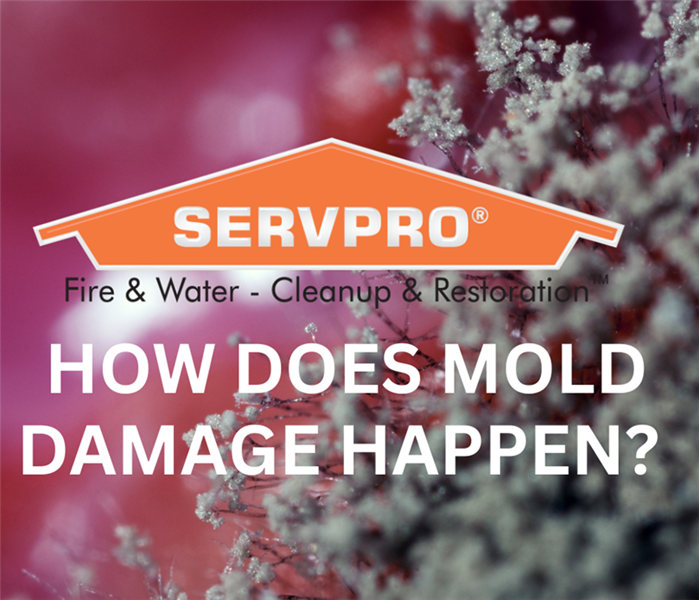 If you suspect mold damage in your building, consult with a professional remediation service to help you address the issue.
If you suspect mold damage in your building, consult with a professional remediation service to help you address the issue.
Mold is a type of fungus that thrives in damp and humid environments. It grows quickly and can spread rapidly, causing damage to the structure of a building and posing a health risk to its occupants.
Causes of Mold Damage
Mold thrives in damp and humid conditions. This means that any area of a building that is exposed to moisture is at risk of developing mold. Some of the most common causes of mold damage include:
- Water leaks: Leaky pipes, roofs, and windows can all contribute to the growth of mold.
- Flooding: If a building is flooded, the excess water can create a perfect breeding ground for mold.
- Humidity: High levels of humidity in a building can create conditions that are ideal for mold growth.
- Poor ventilation: Without adequate ventilation, moisture can become trapped in a building, providing a perfect environment for mold to grow.
Effects of Mold Damage
Mold damage can have a number of negative effects on a building and its occupants. Some of the most common effects include:
- Structural damage: Mold can weaken the structure of a building, leading to cracks, warping, and other forms of damage.
- Health risks: Exposure to mold can lead to a number of health problems, including respiratory issues, allergic reactions, and skin irritation.
- Property damage: Mold can damage walls, floors, and other surfaces, requiring expensive repairs and replacements.
Prevention of Mold Damage
Preventing mold damage is much easier than dealing with it after it has already occurred. Here are some tips for preventing mold growth in your building:
- Keep humidity levels under control: Make sure that your building has adequate ventilation and use dehumidifiers to control humidity levels.
- Repair water leaks: Fix any leaks as soon as they are detected to prevent moisture from building up.
- Keep your building clean: Regular cleaning can help prevent mold growth by removing any spores that may be present.
- Inspect your building regularly: Regular inspections can help you identify any potential problems before they become major issues.
Remediation of Mold Damage
If you suspect that you have mold damage in your building, it is important to address the problem as soon as possible. Here are the steps involved in mold remediation:
- Identify the source of the problem: Determine the source of the moisture that is causing the mold growth.
- Contain the mold: Use barriers to prevent the mold from spreading to other areas of the building.
- Remove the mold: Use specialized equipment and cleaning agents to remove the mold.
- Repair any damage: Repair any damage that was caused by the mold growth.
- Take steps to prevent future mold growth: Take steps to prevent future mold growth by addressing any moisture problems and keeping the building clean.
By understanding the causes and effects of mold growth, as well as how to prevent and remediate it, you can protect your building and the people who use it. If you suspect mold damage in your building, consult with a professional remediation service to help you address the issue.
SERVPRO of Foxborough is your premier choice for fire damage and restoration. Our teams are ready to respond 24 hours a week, any day of the year. When you bring us on the job our team of licensed contractors and certified technicians will work collaboratively with you throughout the duration of the project. They will keep you updated on the project's status and ensure that your expectations are met. We will help you to move forward and make it “Like it never even happened” for all of your fire damage.
SERVPRO of Foxborough Shares Preventing Mold Damage: Essential Tips for a Healthy Home
2/5/2023 (Permalink)
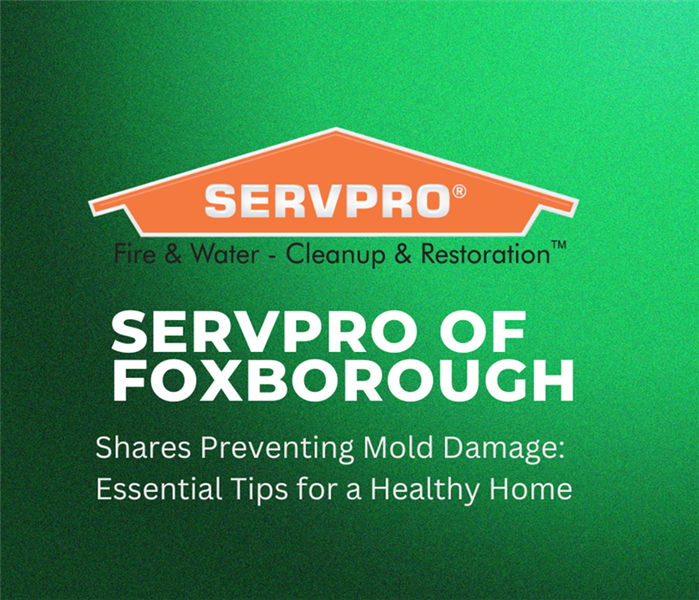 If you suspect mold growth in your home, it is important to have it inspected and professionally remediated to avoid further damage
If you suspect mold growth in your home, it is important to have it inspected and professionally remediated to avoid further damage
Mold damage can be a major problem in many homes. It is important to understand the conditions that allow mold to thrive and what steps can be taken to prevent its growth.
Here are some tips to help you prevent mold damage in your home:
- Control humidity levels: Mold thrives in moist environments, so it is essential to keep indoor humidity levels low. Use a dehumidifier to remove excess moisture from the air.
- Fix leaks: Promptly fix any leaks in your roof, walls, or plumbing to prevent water damage and mold growth.
- Keep surfaces clean and dry: Regularly clean and dry surfaces in high-risk areas such as bathrooms, kitchens, and basements. Use a mold-resistant cleaning solution to disinfect surfaces and prevent mold from growing.
- Increase ventilation: Ensure that your home has proper ventilation to help prevent mold growth. This can be achieved by opening windows and doors regularly, using exhaust fans, and keeping air vents clear.
- Inspect and maintain HVAC systems: Your heating, ventilation, and air conditioning systems can become a breeding ground for mold if not properly maintained. Inspect them regularly and have them serviced by a professional if needed.
- Store items properly: Store items, especially paper products and organic materials, properly in sealed containers to prevent mold growth.
- Regularly inspect your home: Regular inspections of your home can help identify mold damage early, allowing you to take action before it becomes a bigger problem. Look for discoloration on walls and ceilings, a musty odor, or any other signs of moisture damage.
You can help prevent mold damage in your home, protecting your family's health and your home's structure. If you suspect mold growth in your home, it is important to have it inspected and professionally remediated to avoid further damage
SERVPRO of Foxborough is your premier choice for fire damage and restoration. Our teams are ready to respond 24 hours a week, any day of the year. When you bring us on the job our team of licensed contractors and certified technicians will work collaboratively with you throughout the duration of the project. They will keep you updated on the project's status and ensure that your expectations are met. We will help you to move forward and make it “Like it never even happened” for all of your fire damage.
Is A Mold Inspection Necessary When Purchasing Commercial Property
10/18/2019 (Permalink)
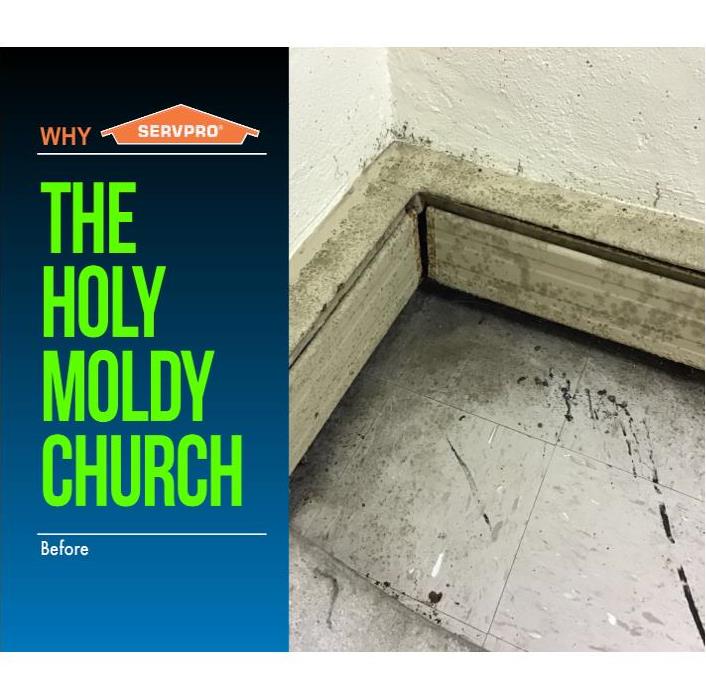 Corner of Church walls, floorboard heaters and tile flooring covered in mold
Corner of Church walls, floorboard heaters and tile flooring covered in mold
When you consider purchasing a commercial property in the Foxborough area, you likely have a checklist of things to look for. The building not only has to suit all your business needs but it must be structurally sound. This means checking for signs of mold and knowing when you may need a mold inspection.
Know Where to Look
Mold grows best in damp, moist conditions. As you walk through the property, consider any areas of the building that fit this description, and keep an eye out for signs of water damage. Some notable places to look for visible mold include:
- Bathrooms - Check near showers, sinks, tubs and toilets.
- Basements - Pay attention to signs of leakage or condensation on pipes, as well as flood-prone areas.
- Windows - Rainwater leaks and condensation from humidity can cause mold formation.
Of course, mold is not always visible. It can lurk within HVAC ducts and behind walls, ceilings or floorboards. If you notice any current or previous signs of water damage, you should consult the experts at SERVPRO of Foxborough to determine the extent of any infestation.
Inspection and Remediation
If there are no signs of mold or water damage, it may not be worthwhile to pay for a mold inspection. However, if you suspect a problem, trained inspection and restoration experts can help you determine the extent of the issue and figure out a cleanup method. The good news is that even if your ideal property has a slight mold problem, this does not mean it is out of the running. With the assistance of skilled mold remediation experts at SERVPRO of Foxborough, the route cause will be identified and fixed followed by proper remediation of any infestation.
CDC Facts on Mold
6/25/2018 (Permalink)
According to the Center for Disease Control and Prevention's website:
There is always some mold everywhere – in the air and on many surfaces. Molds have been on the Earth for millions of years. Mold grows where there is moisture.
Mold and Your Home
Mold is found both indoors and outdoors. Mold can enter your home through open doorways, windows, vents, and heating and air conditioning systems. Mold in the air outside can also attach itself to clothing, shoes, bags, and pets can and be carried indoors.
Mold will grow in places with a lot of moisture, such as around leaks in roofs, windows, or pipes, or where there has been flooding. Mold grows well on paper products, cardboard, ceiling tiles, and wood products. Mold can also grow in dust, paints, wallpaper, insulation, drywall, carpet, fabric, and upholstery.
If you suspect the presents of mold in your house please give our expects a call at SERVPRO of Franklin/Walpole 508-533-5305
Industrial Hygienist
6/25/2018 (Permalink)
If you suspect you have a mold issue give us a call today at 508-533-5305! If you suspect you have an issue but are unable to actually see the mold you may need what we in the industry call an Industrial Hygienist to come out and do some testing.
The company we turn to is always Oasis Environmental.
For over fifteen years, Oasis Environmental Contracting Services, Inc. (Oasis) has been providing quality environmental advice and support to there valued clients. Oasis is veterans owned business/registered with CCR Cage/NCAGE 5KC12.
Oasis provides an eclectic array of environmental services and products, and we specialize in Environmental Investigations. Their meticulous and unique forensic approach provides clients with the historic data considered necessary to formulate options and make educated decisions regarding difficult environmental questions.
Matthew E. Montefusco, CHMM, CMC, CES, founded Oasis on the premise that individuals faced with environmental problems prefer and deserve a calm place (an Oasis) to obtain sensible and cost effective solutions to their particular situation. With Mr. Montefusco's twenty-nine plus years of environmental experience and the diligent efforts of the Oasis conscientious staff, environmental problems can be solved in a professional manner with the client's best interest in mind.
For more information contact our office at SERVPRO of Franklin/Walpole.
BLEACH vs MOLD ~ Who Knew?
4/10/2018 (Permalink)
Despite popular belief, BLEACH DOES NOT KILL MOLD on porous surfaces!
Because Mold grows in colonies and has roots which grow deep into the material, bleach will NOT kill Mold in its entirety. Bleach will kill the surface Mold but the water content contained in bleach will actually worsen Mold conditions! Mold is a living organism which means it needs food to survive. Within a porous structure, Mold will use the water in bleach as a food source to feed its roots. This will actually cause the mold to grow back stronger!
The following are some Interesting, Educational FACTS about BLEACH and MOLD
- The Clorox ® Company, EPA and OSHA have specifically advised that Bleach should not be used in mold remediation
- Bleach does not kill mold, it will only remove the stain caused by mold
- Bleach in some cases will allow toxic mold to grow where it was not present before
- Bleach itself is considered to be toxic and is classified the same as gasoline
- Bleach on gypsum (the material found in sheet rock or drywall) will emit chlorine gas for at least a week
- Bleach applied to wood will push mold spores deeper into the wood fibers creating more problems later
- Bleach does more harm than good
Contact SERVPRO of Franklin/Walpole TODAY to Remediate YOUR Mold Issue!
Are conditions in your town right for Mold?
4/2/2018 (Permalink)
It’s estimated that more than 1 million types of mold exist, yet less than 10 percent have actually been named. This means mold is very common in both indoor and outdoor environments. While mold and humans can sometimes co-exist without issue, there are certain species of mold that can cause health effects for some people.
If the right conditions exist, mold will grow. Those conditions include:
- Water - Different mold types require varying amounts of liquid before growth begins.
- Temperature - Normal indoor temperatures will promote mold growth.
- Time - Initial mold colonizers can take hold within one day after being exposed to an adequate water supply.
Mold growth can occur in any home, so it’s important to keep an eye out for situations that might promote mold activity. Roof/chimney leaks, wet basements, or condensation from ducts that dampen surrounding insulation are just a few examples of issues that make a house a prime target for mold growth.
If you suspect mold in your home, call SERVPRO of Franklin/Walpole to assess the situation. We have the knowledge, tools and track record to effectively remediate mold in your home or business.
If you suspect mold, call us today at 508-697-5439
What to Do:
- Stay out of affected areas.
- Turn off the HVAC system and fans.
- Contact SERVPRO of Franklin/Walpole for mold remediation services
Mold Tips
4/2/2018 (Permalink)
If you see visible mold, do not disturb it. You can inadvertently spread the mold infestation throughout your home. When mold is disturbed, the mold can release microscopic mold spores which become airborne and can circulate inside your home.
What to Do:
- Stay out of affected areas.
- Turn off the HVAC system and fans.
- Contact SERVPRO of Franklin/Walpole for mold remediation services.
What Not to Do:
- Don’t touch or disturb the mold.
- Don’t blow air across any surfaces with visible or suspected mold growth.
- Don’t attempt to dry the area yourself.
- Don’t spray bleach or other disinfectants on the mold.
About Our Mold Remediation Services
SERVPRO of Franklin/Walpole specializes in mold cleanup and restoration, in fact, it’s a cornerstone of our business. Our crews are highly trained restoration professionals that use specialized equipment and techniques to properly remediate your mold problem quickly and safely.
If You See Signs of Mold, Call Us Today – 508-697-5439
Kitchen Mold - Plymouth, MA
5/12/2017 (Permalink)
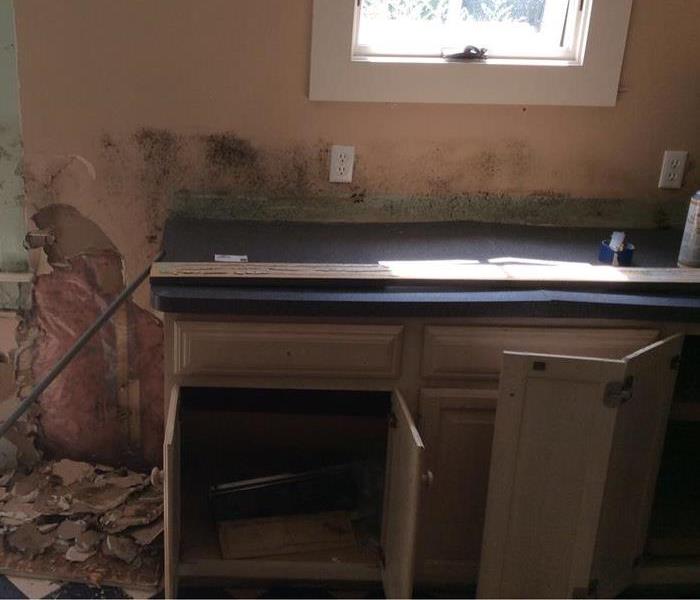 During a kitchen renovation this homeowner found mold.
During a kitchen renovation this homeowner found mold.
Your kitchen can be a melting pot for the growth of mold. Outside leaking pipes, here are 7 sources that could help with the growth of mold.
The Refrigerator Drip Tray: This tray is easily forgotten. It is found under the fridge, it could be in the back under the fan grate, or bottom front.
Garbage Disposal: Mold can grow on rotting food in the garbage disposal if you don't keep it clean. To help avoid mold, pour vinegar down at least once a week.
Compost: Another less thought of mold source is the compost bucket. Make sure to remove it every day and keep covered.
Cutting Boards: In most homes this item is used on a daily basis, but it is a good source for mold growth. Cleaning it once a week with vinegar and let stand for 10 minutes before rinsing should cut down on the threat of mold.
If you have a mold growth in your home contact SERVPRO of Franklin/Walpole at 508-533-5305 for your professional cleaning
Basement Mold - Canton, MA
5/12/2017 (Permalink)
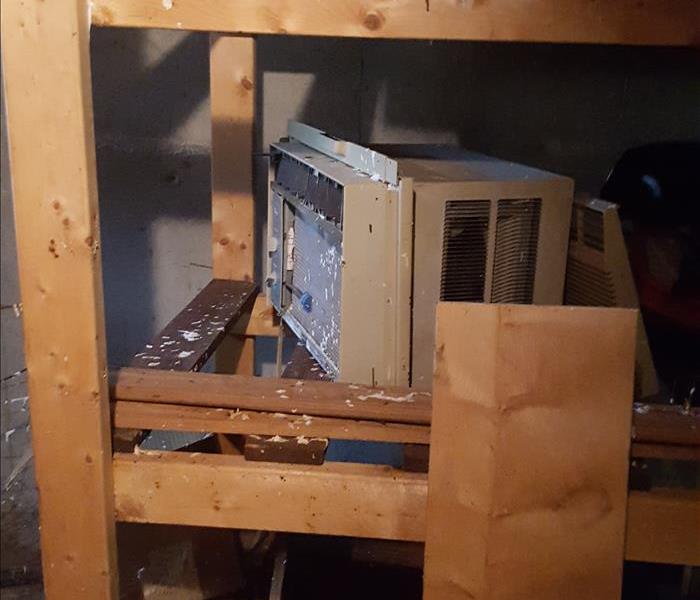 What to do when you find mold in your basement.
What to do when you find mold in your basement.
One of the areas in your home where you would most likely see mold is in your basement. Because the basement gets not sunlight, very little ventilation and is often humid it is prime real estate for mold to grow.
Mold can grow on most every thing, drywall, building frames, carpet, insulation to name a few. When looking for mold looks for signs of moisture.
In order to prevent basement mold you must minimize moisture. Here are a few tips.
Basement Walls: If you see water seeping through the walls applying sealant to walls and floors would prevent water from getting in.
Leaking Pipes: Look over pipes for any condensation or leaks, and get them fixed.
Basement Humidity: It's important to keep the humidity at below 55%. Buying a dehumidifier would would reduce the risk of mold in you basement.
If you have mold in you basement contact SERVPRO of Franklin/Walpole at 508-533-5305 where our trained and certified technicians can rid your home of mold.
Attic Mold - Plymouth
3/27/2017 (Permalink)
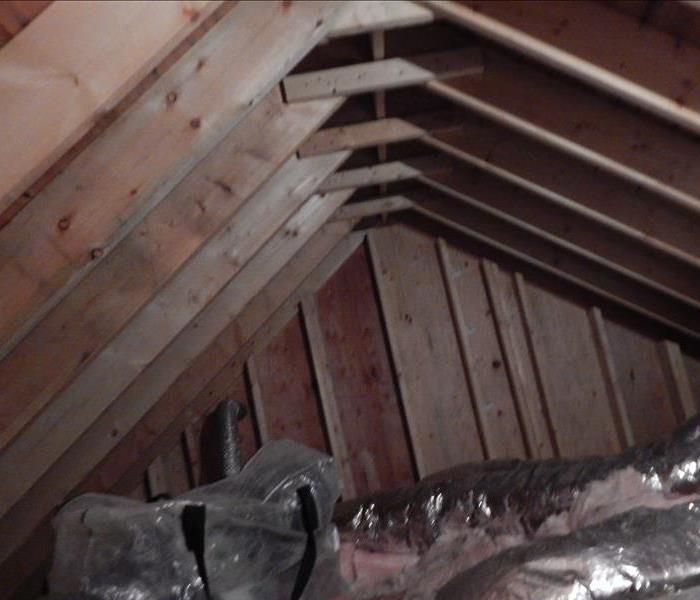 The mold in this attic was not discovered until the homeowner went to get the Halloween decorations.
The mold in this attic was not discovered until the homeowner went to get the Halloween decorations.
What can you do when you have found mold growth in your attic. SERVPRO of Franklin/Walpole have narrowed down the 6 most common causes of mold growth in you attic.
If you're like a lot of people you probably store all your holiday decorations in the attic. During these times it would be a good time to inspect your attic for mold. For some there could be a nasty surprise waiting for us.
SERVPRO of Franklin/Walpole has comprised the 6 common causes.
1: A leaking roof.
2: Missing or improperly installed insulation.
3: Inadequate Ventilation.
4: Dryer vents, kitchen and/or bathroom fans vented into the attic. This practice can pump warm moist air into the attic creating the correct environment for mold growth.
5: Water heaters or furnaces installed in the attic.
6: Ice damming.
If you think you might have mold growth contact SERVPRO of Franklin/Walpole at 508-533-5305 to set up an appoint for one of our experience technicians for their opinion today.
Skylight Mold - Milton, MA
3/27/2017 (Permalink)
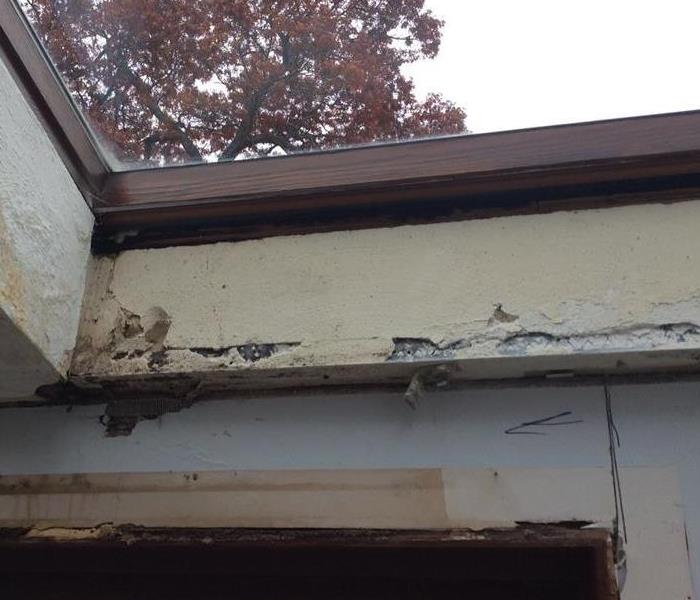 Mold found around this leaky skylight in Milton, MA
Mold found around this leaky skylight in Milton, MA
Condensation is usually more noticeable on skylights because warm, moist air rises to the ceiling. The problem, however, usually isn't the skylight it's the excess moisture in the room.
Skylights are often installed in bathrooms but sometimes in bedrooms and kitchens. The appeal is understandable. Skylights window, are defined as windows installed at an angle. While they look pretty down the road they can lead to uncomfortable conversations.
The key to mold control is moisture control. Managing excess moisture in your home can help prevent the growth of mold. monitoring your home regularly will help to keep the mold to a minimum.
Open your skylights to reduce humidity and to allow air to circulate. This will reduce the buildup of moisture, which is the biggest cause of mold. If you see a build up of condensation open the window if you can, or run a fan, this will help the air to move.
Mold will never be anyone's idea of a welcomed house guest, but with preventive steps you can be assured you will never have to fear those three letters words: "you have mold".
If you think you have mold give SERVPRO of Franklin/Walpole a call today for your evaluation at 508-533-5305
Window Mold-Sharon, MA
3/27/2017 (Permalink)
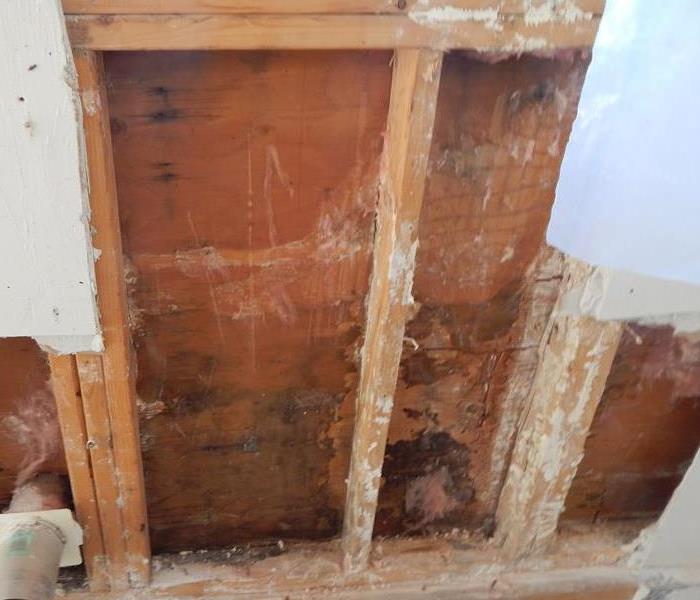 Mold strikes a garage window in Sharon, MA
Mold strikes a garage window in Sharon, MA
MOLD: The very word is enough to make a person cringe.
Mold can be good- it's essential in making brie and penicillin, for example, and necessary for the decomposition of organic matter in nature-but it can also be very, very bad, especially when it grows undetected in your home. Mold can grow anywhere: on carpet, clothing, food, paper, and even in places you can't see such as the backside of drywall, areas inside walls around leaking or condensing pipers, and above ceiling tiles.
Here are nine ways to curb moisture indoors, and the mold that thrives on it.
1: Identify problems areas in your home and correct them.
2: Dry wet areas immediately.
3: Prevent moisture with proper ventilation
4: Equip your home with mold-resistance products.
5: Monitor Humidity indoors.
6: Direct water away from your home.
7: Clean or repair roof gutters.
8: Improve air flow in your home.
9: keep mold off household plants.
Have questions, give SERVPRO of Franklin/Walpole a call today at 508-533-5305 someone will be able to assist you.
Basement Mold-Somerset, Ma
3/27/2017 (Permalink)
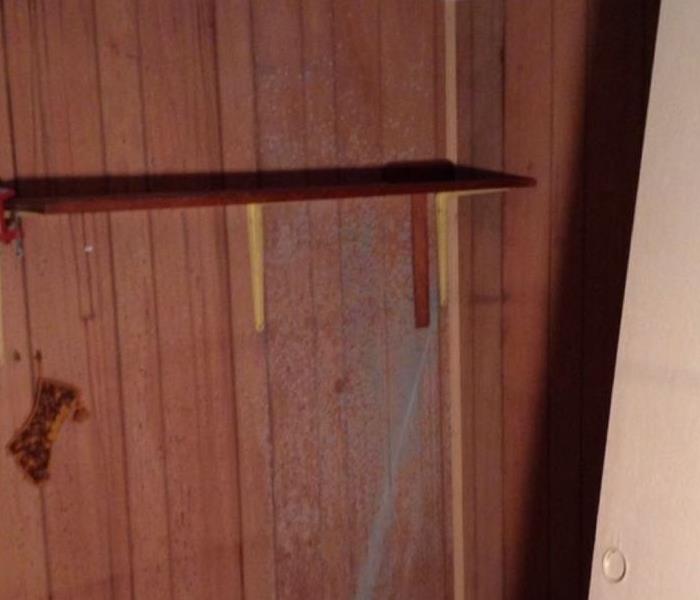 Mold build up at a basement in Somerset, MA
Mold build up at a basement in Somerset, MA
The basement is one of the areas in your home that is prone to mold growth usually from the high level of moisture, inadequate ventilation and a lack of dehumidifying.
Mold formation in the basement can easily go unnoticed because people hardly go their and as such the growth can spread extensively. Because mold can grow on any organic item, it is a good idea to check every item in the basement to spot mold growth.
Items prone to mold growth include wooden furniture, boxes, cartons, paper, drywall's, carpets and any wood structures that constitute the basement.
To keep basement free from mold, take extra care to keep it dry always. Possible sources of moisture include floods, leaking pipes and faulty ventilation.
If you think that you have mold in your basement give SERVPRO of Franklin/Walpole a call at 508-533-5305
Bleach and Mold the hard truth!
5/11/2016 (Permalink)
Bleach does not kill mold on porous surfaces. Mold grows in colonies and has roots which grow deep into the material. The bleach will infact kill the surface mold however the water content of the bleach will seep into the porous structure and provide a food source to the roots. This will actually cause the mold to grow back stronger.
Here are some facts about Bleach and Mold
- The Clorox ® Company, EPA and OSHA have specifically advised that Bleach should not be used in mold remediation
- Bleach does not kill mold, it will only remove the stain caused by mold
- Bleach in some cases will allow toxic mold to grow where it was not present before
- Bleach itself is considered to be toxic and is classified the same as gasoline
- Bleach on gypsum (the material found in sheet rock or drywall) will emit chlorine gas for at least a week
- Bleach applied to wood will push spores deeper into the wood fibers creating more problems later
- Bleach does more harm than good





 24/7 Emergency Service
24/7 Emergency Service




















